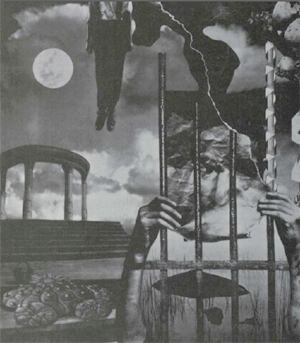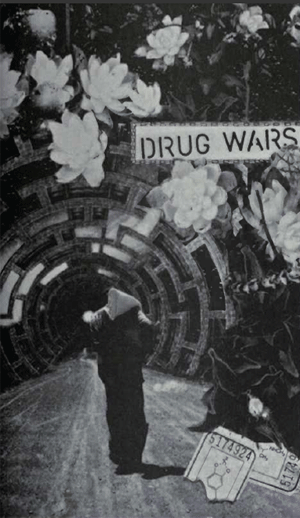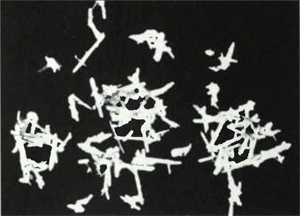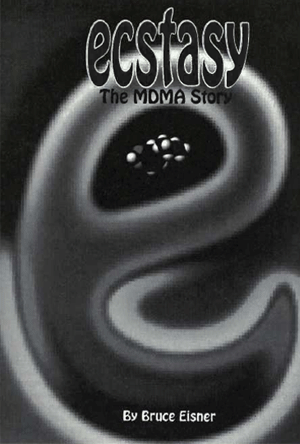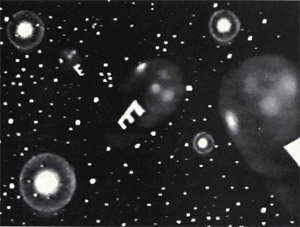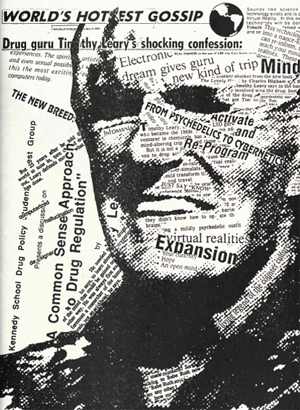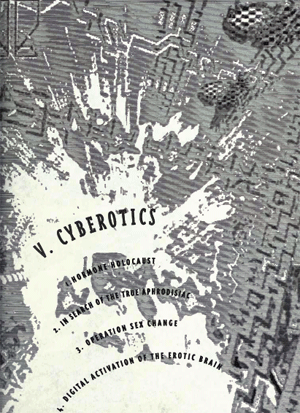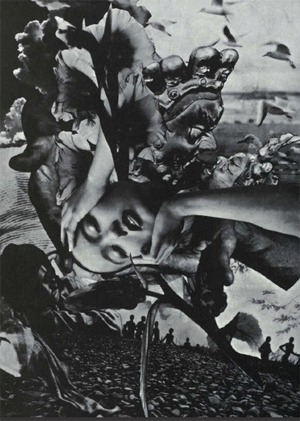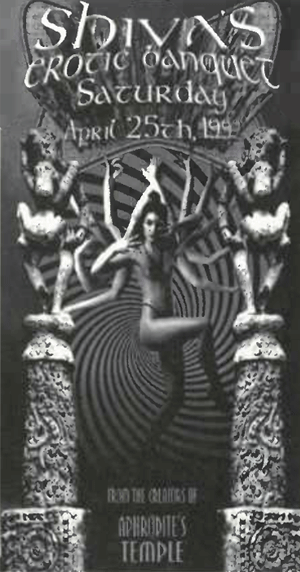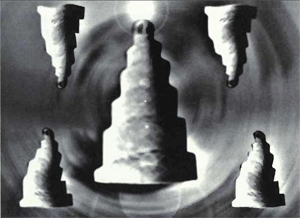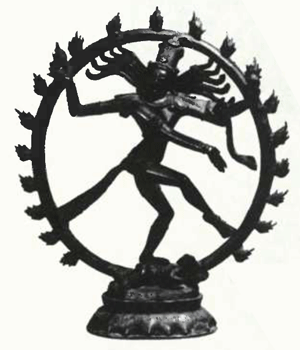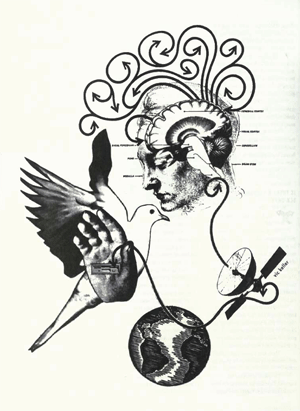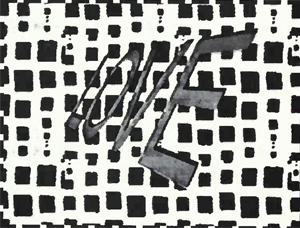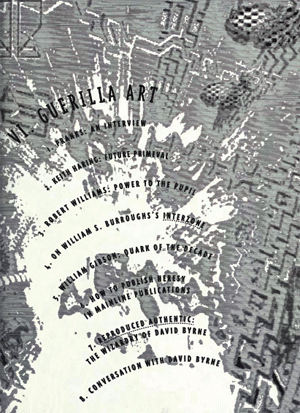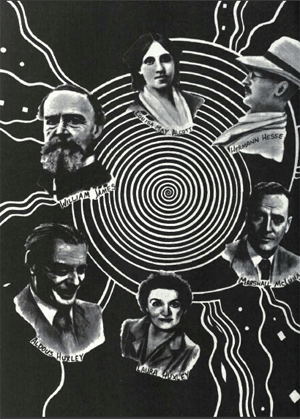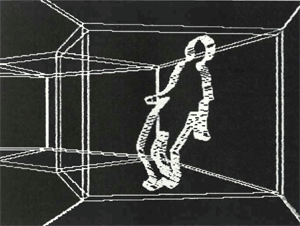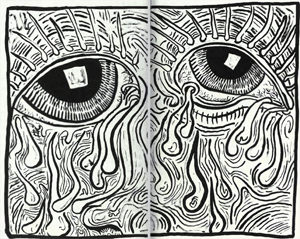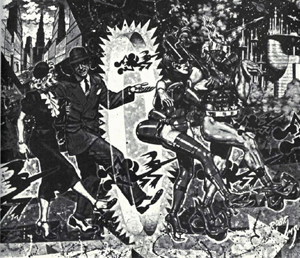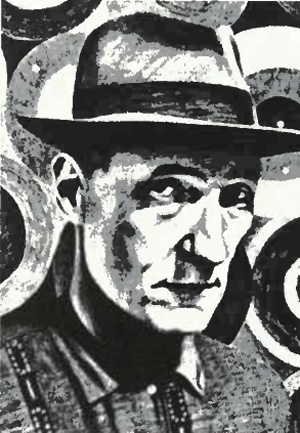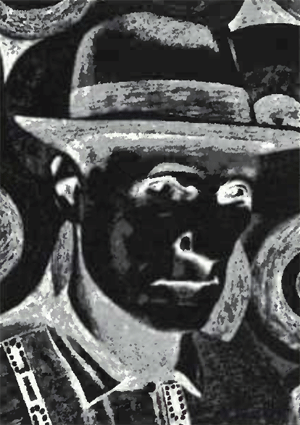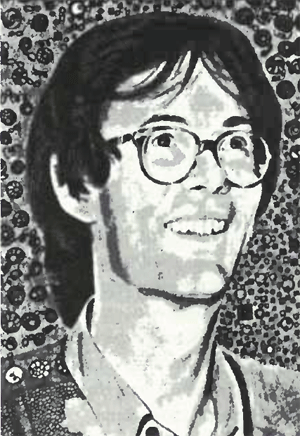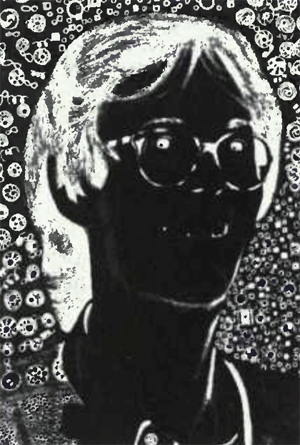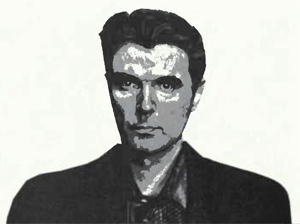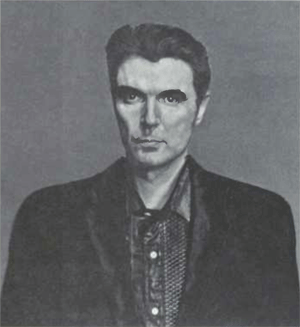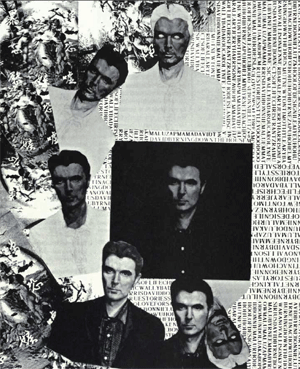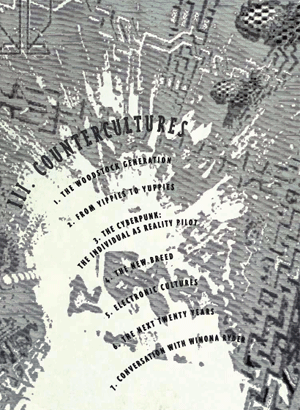
III. COUNTERCULTURES
1. The Woodstock Generation
2. From Yippies to Yuppies
3. The Cyberpunk: The Individual as Reality Pilot
4. The New Breed
5. Electronic Cultures
6. The Next Twenty Years
7. The Godparent: Conversation with Winona Ryder
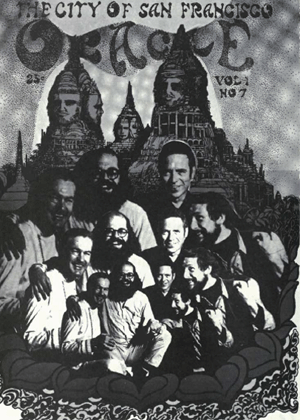
III.1. The Woodstock Generation
It was twenty years ago this summer that more than four hundred thousand young Americans spent three days and nights carousing spectacularly at the Woodstock rock festival. It was simply the biggest and wildest and most influential party in all of history! If not, please prove me wrong, so that we can learn how to improve.
It was twenty years ago today...
For one weekend this farm field became the third largest city in New York state. Almost half a million spoiled, affluent, educated young Americans crowded, jammed, squashed into a small cow pasture in upstate New York.
There was minimum sanitation. Minimum food (which was, of course, lovingly shared). Wall-to-wall mud. That's the down side.
On the up side these concert-goers experienced the greatest pagan, Dionysian rock 'n' roll musical event ever performed, with plenty of joyous nudity, and wall-to-wall psychedelic sacraments.
And click on this: not one act of recorded violence!
The Woodstock festival was an all-star revival of the oldest and most basic religious ritual: a pagan celebration of life and raw nature, a classic group “possession ceremony” in which worshippers “go out of their minds” to recklessly confront the chaotic Higher Sources, protected by the power of group support.
Check the anthropology texts. Read Campbell, read Frazer, and you’ll see that these rituals date way back before the upstart, aggressive, pushy, puritanical monotheistic (One Male God) religions. Pagan rites always celebrate the same natural, instinctive, guileless, eternal utopian values: Peace. Pure ecstatic sexuality. Equality in the eyes of the Higher Powers. Joy. Endemic rapture. Mirth. Tolerance. Affirmation of life, of the human spirit The honest naked human body. Irreverence. And merry laughter.
Such festivals reawaken the oldest and most utopian aspirations of the human brain.
However, be warned. If you stand up as an individual and declaim these goals, you are sure to be derided by the Rambo-Liddy-Ollie North steroid gang (and probably by most of the important adult authorities in your sector) as a hopeless, naive idealist “The world is a tough, mean neighborhood,” you will be told by the conventional-wisdom experts.
But when four hundred thousand energetic, educated young people assembled, in August 1969, to proclaim these venerable pagan values in action, the effect was contagious. A fearless confidence flared up in young adults. You’ve seen the films of the 1960s. Sunny, impertinent smiles were infectious. A sense of undeniable togetherness. No secrecy. No shame for experiencing pagan moments. Psychedelic herbs proudly and openly exchanged. Can you imagine anyone sneaking off at Woodstock to shoot heroin behind a bush? Or surreptitiously tooting cocaine? Or sneakily dropping steroids—while listening to Jimi Hendrix and the Grateful Dead?
This “Woodstock experience” became the role model for the counterculture of that time. The Summer of Love kids went on to permanently change American culture with principles that the Soviets in 1989 called glasnost and perestroika.
The War on Drugs made mellow marijuana prohibitively expensive. The DEA made sure that the peaceable, visionary elixirs like ’shrooms, mescaline. LSD, and MDMA became inaccessible. So good-bye to turn on, tune in, drop out... and hello to the motto of the 1980s: Hang on. Hang in. Hang over.
Hippies started the ecology movement They combated racism. They liberated sexual stereotypes, encouraged change, individual pride, and self-confidence. They questioned robot materialism. In four years they managed to stop the Vietnam War. They got marijuana decriminalized in fourteen states during the Carter administration. Etc.
There was another by-product of the ’sixties generation so obvious that it is rarely considered. When more than four hundred thousand virile, nubile, horny young men and women assembled in the atmosphere of life affirmation there was, inevitably “a whole lotta shaking goin’ on.” It’s possible that ten thousand babies were conceived that magical weekend in 1969.
Where are these “kids of the ’sixties kids” today? And who are they?
The babes of the Woodstock season are now, in 1989, twenty years old. In the next twelve years their younger cohort members will be swamping the college campuses.
Will these college kids of the 1990s, the grandchildren of Dr. Spock, be different from the conservative college kids of the 1980s?
If your Mom was running around bare-ass at Woodstock... if your Dad helped Abbie Hoffman levitate the Pentagon and helped end the Vietnam War... if your parents smoked dope during their formative years while listening to Dylan, the Rolling Stones, and the Beatles... if they wept at the fascist-assassination deaths of the Kennedys, Martin Luther King, Jr., and John Lennon... if your folks turned on, tuned in, dropped out... are you going to major in Business Administration and stampede to Wall Street to sell illegal junk bonds?
The poor, conservative, fearful, conforming college students of the Reagan years w ere stuck with Moms and Dads who grew up in the bland Eisenhower 1950s. The ghosts of that decade—Senator (Red-Scare) McCarthy and General Douglas (“nuke the slant-eyes”) MacArthur and John Wayne and Father Knows Best came back to haunt the colleges in the 1980s.
THE REAGAN GENERATION

The Woodstock revolution started in 1966, peaked in in 1976, and hit the wall with a thud! in 1980 with the election of Nancy Reagan.
During the 1980s the gentle tolerance of Woodstock was replaced by a hard-line Marine Corps attitude. The pacifism of “Give Peace a Chance” gave way to a swaggering militarism. The conquest of Grenada. The glorious bombing of Qaddafi’s tent. The covert war against Nicaragua. Star Trek gave way to Star Wars.
The War on Drugs made mellow marijuana prohibitively expensive. The DEA made sure that the peaceable, visionary elixirs like ’shrooms, mescaline, LSD, and MDMA became inaccessible. So good-bye to turn on, tune in, drop out... and hello to the motto of the 1980s: Hang on. Hang in. Hang over.
And what did the War on Drugs produce? A booze epidemic. Alcohol—the drug of choice of the NRA, the Bubba hunting crowd, the American Legion—is back in the saddle.
Turn down! Tune out!
Throw up!
And cocaine. An epidemic of toot, snort, snow, blow, base, crack has the inner cities wired and fired. Cocaine, the drug that fueled Hiller’s SS and the Nazi Blitzkrieg suddenly is turning the inner cities of Reagan-Bush America into battlegrounds! Guns, rifles, automatic weapons conveniently supplied by the NRA and your government-licensed gun dealer. Just walk up and name your weapon, Bucko. No questions asked.
Thru out! Shoot up!
Drop dead!
And here’s a pharmaceutical plus for the post-Woodstock America: what unique new Rambo drug did the stand-tall, muscle-bound Reagan-Bush regime give our youth to replace the wimpy Carter years?
Steroids!
Turn off! Tune out!
Pump up!
(Thanks a lot, Nancy.)
What about the college kids? Remember, the ’sixties counterculture was centered on the campus¬ es. Berkeley. Rent State. Columbia. Madison. Austin. Boulder. Seattle. In the 1980s, however, the colleges, the source of our future, have “seethed with rest” While brave students in South Korea, China, the Soviet Union were exhibiting the idealism they dutifully learned from Woodstock, back in America students have become conservative, materialistic, career-oriented, like the Japanese universities, and like the Russian colleges under Brezhnev.
In the last ten years there has been little campus concern for social issues. The Dan Quayle fraternity-sorority system flourished again. The ultimate college clowns, ROTC students, grown men and women dressed like Boy Scouts sporting Ollie North crewcuts, became, if not popular, at least acceptable.
The audible symbol of this change from the 1960s to the 1980s is the music. If you want to find the soul of a culture, listen to the lyrics that direct the sounds, the beats, the rhythms.
In the 1960s Dylan sang: “We ain’t gonna work on Maggie’s farm no more.” Lennon sang: “Give Peace a Chance.” In the somnambulant 1980s Michael Jackson, Prince, Madonna, George Michael kept us moving in the big auditorium-arenas under the watchful eyes of the security guards, but the lyrics are not high in socially redeeming value, while the anger of young activist musicians is limited to the denigrated punk-club scene.
Conservative politicians and fundamentalist preachers were delighted by the new conformity. College professors who were proud veterans of the ’sixties counterculture vainly expected the new students to carry on the individual-freedom tradition. The more thoughtful students sensed that they were somehow missing something. The sad nostalgia of tie-dye T-shirts couldn’t revive the spirit.
THE SUMMER OF LOVE
How did the Summer of Love turn into the Winter of Irangate and drive-by shootings?
How long will this conservatism last? Will the 1960s renew? The answer is easily found in the demographics.
These conformist kids who were 20 years old in 1980 were raised by parents whose teenage social ideals emerged in the button-down 1950s. The replay is uncannily precise.
Back then we had a lovable old doddering president named Ike whose political tactics were a reassuring grin. There was a big Evil Empire Crusade that led to the pointless slaughter of the Korean War. And if your parents could tolerate Tricky Dick Nixon as vice president in 1959, then you are more able to swallow Dan Quayle as our second-in-command in 1989!

In the 1950s, the domestic cancer—the number-one peril that was threatening our nation from within—was subversive communism. Welcome to a thrilling Civil War that unleashed FBI agents and hard-line police goons to crack down and harass pinkos, communist sympathizers, traitorous peaceniks, and liberals who supported un-American plots to bring about racial and sexual equality.
The 1980s have given us a sequel to McCarthyism. The Civil War on Drugs has unleashed federal agents and hard-line police goons (led, believe it or not, by a “czar”) to harass libertarians, intelligent hedonists, and thirty million marijuana fans who don’t want the government telling them what to do with their minds.
The 1980s have given us a sequel to McCarthyism. The Civil War on Drugs has unleashed federal agents and hardline police goons (led, believe it or not, by a "czar") to harass libertarians, intelligent hedonists, and thirty million marijuana fans who don't want the government telling them what to do with their minds.
The ’eighties witchhunt involves, not loyalty tests by the FBI, but mandatory urine tests by the DEA. The same inquisitional fanaticism is at work.
Careerism and unquestioning acceptance of authority were valued in the 1980s as then, in the 1950s. There was not a whimper in the 1950s when millions of youth were drafted and sent six thousand miles away to invade Korea. The most visible rowdy culture hero, Elvis Presley, reported dutifully to his local draft board, dressed up like a cute soldier boy, saluted smartly for the cameras, and coached by his father figure, Colonel Parker, proclaimed, “I’m looking forward to serving in the Army. 1 think it will be a great experience for me.” (Sometime after his military service in Germany, Elvis wobbled into the office of J. Edgar Hoover while loaded on prescription drugs and volunteered to be a drug informant for the FBI. He boasted that his contacts with musicians would make him an ideal double agent. No John Lennon he.)
For an ’eighties college student whose parents’ wildest moments of cultural individuality and social passion involved panty raids and fraternity-house telephone-booth pranks, is it surprising for them to appear apathetically cheerful in the Reagan-Bush period? Right-wingers and fundamentalists have exulted in the apathy and conformity of ’eighties campuses. “America,” they exult, “has come to its senses. Father knows best!”
The ideals of the 1960s—of individuality, personal freedom, kick-out free expression—were written off as adolescent delinquency. American kids, thank God, have assumed the sober responsibilities of history—to wage the Cold War, to go to church and vole Republican (or Democratic, since it doesn’t really matter), to dress and behave with decorum, to support the military and police who defend us against our deadly foes abroad and the enemies in our urban slums and ghettos.
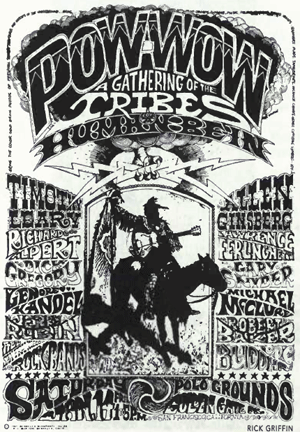
RICK GRIFFIN
By 1989, however, this right-wing fantasy was beginning to erode in the light of the new explosions of youthful idealism.
Twenty years after Woodstock, the national news once again is featuring hundreds of thousands of young people behind the Iron Curtain, their faces glowing with patriotic idealism, peaceably demonstrating to overthrow an aging federal bureaucracy. It’s powerful deja vu to witness long-haired German kids wearing headbands, flashing the universal peace sign, and putting their bodies and careers on the line for democracy and individual rights. Once again the confrontations with students peacefully defying the National Guard. Once again the daring yet playful tactics of television agit-prop theatre substituted for violence. Thousands of protesters riding bicycles (!) to the revolution! What would Karl Marx make of that maneuver?
Where did those Chinese students learn these clever methods of grabbing the news screens to express their ideals? Where did they learn the techniques of media savvy to counter the armed forces of the state? From the newsreel films of the American campus protests of the late 1960s, whose ideals are not dead. They were more powerful than ever in China’s Tien An Men Square, as well as in the USSR, where glasnost and perestroika define freedom for the individual.
The youth in China, Russia, Czechoslovakia, South Korea are the kids of the ’sixties kids. Keep your eyes open, and you’ll see a revival of this freedom movement coming soon to a college campus near you.
III.2. From Yippies to Yuppies
Since my deportation from Harvard University many years ago, I have been, among other things, a freelance college professor paid by students for one-night-stand lectures about topics too hot for salaried professors.
Back in the 1960s when I flew in for a lecture, the student committee showed up at the airport wearing long hair, sandals, blue jeans, and cheerful, impudent grins. The radio would be blasting out Mick Jagger and Jimi Hendrix as we drove to the campus. The students eagerly asked me about "high” technologies—methods of consciousness expansion, new brands of wonder drugs, new forms of dissident protest, up-to-date developments in the ever-changing metaphysical philosophies of rock stars: Yoko Ono’s theory of astrology; Peter Townsend’s devotion to Baba Ram Dass. I kept abreast of these subjects and tried to give responsive answers.
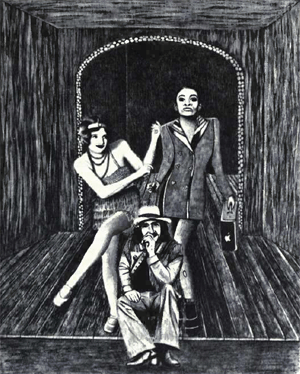
CAROLYN FERRIS
This much we know: The yuppies are a new breed. They’re the first members of the electronic society. They’re the first crop of bewildered mutants climbing out of the muck of the industrial (late neolithic smokestack) age. ... These postwar kids were the first members of a new species, Homo sapiens electronicus.
Today it’s different The lecture committee arrives at the airport wearing three-piece suits, briefcases, clipboards with schedules. No music. No questions about Michael Jackson’s theory of reincarnation or Sheena Easton’s concept of sugar walls. The impudent grins are gone. The young people are cool, realistic, and corporate-minded. They question me about computer stocks, electronic books, and prospects for careers in software.
The phrase "young urban professionals” doesn’t tell us much. I guess the implication is that they are not ORAs (old rural amateurs). But who are they?
ANATOMY OF A YUPPIE
The phrase “young urban professionals” doesn’t tell us much. I guess the implication is that they are not ORAs (old rural amateurs). But who are they?
The moralists of both left and right can froth with righteous indignation about this army of selfish, career-oriented, entrepreneurial individualists who apparently value money and their own interests more than the lofty causes of yesteryear. But behind the trendy hype, we sense that the twitchy media may be reflecting some authentic change in the public consciousness. The yuppie myth expresses a vague sense that something different, something not yet understood but possibly meaningful, is happening in the day-to-day lives and dreams of young people growing up in this very unsettling world.
Surely it’s important to understand what’s going on with this most influential group of human beings on the planet—the 76 million materialistic, educated or streetwise, performance-driven Americans between the ages of 22 and 40.
This much we know: The yuppies are a new breed. They’re the first members of the electronic society. They’re the first crop of bewildered mutants climbing out of the muck of the industrial (late neolithic smokestack) age. They showed up on the scene in 1946, a watershed year, marking the end of World War II—the war that induced the birth of electronic technology: radar, sonar, atomic fission, computers. In 1946, this incredible high-tech gear was beginning to be available for civilian consumption.
Something else important happened in 1946. The birthrate in America unexpectedly doubled. Between 1946 and 1964, 76 million babies were born. That’s 40 million more than demographers predicted. These postwar kids w ere the first members of a new species, Homo sapiens electronicus. From the time they could peer out of the crib, they were exposed to a constant shower of information beaming from screens.
They were, right from the start, treated like no other generation in human history. Their parents raised them according to Dr. Benjamin Spock’s totally revolutionary theory of child care. “Treat your kids as individuals,” said Spock. “Tell them that they are special! Tell them to think for themselves. Feed them, not according to some factory schedule. Feed them on gourmet demand, i.e., let ’em eat what they want when they are hungry.”
This generation is the most intelligent group of human beings ever to inhabit the planet The best educated. The most widely traveled. The most sophisticated. They have grown up adapting to an accelerated rate of change that is almost incomprehensible. They became highly selective consumers, expecting to be rewarded because they are the best.
Let’s hasten to clear up one misconception here. This postwar generation of Spockies was not docilely manipulated by greedy admen or the cynical media. Nor was it the so-called imagemakers, the rock stars and television programmers and moviemakers, telling the kids what to do. Quite to the contrary. The Spockies themselves dictate to the imageers and marketeers about what they want.
BABY-BOOMERS GROW UP
The rapidly changing style and tone of American culture in the last four decades has reflected the elitist expectations of this Spock generation as it passed through the normal stages of maturation.
During the 1950s, kids were cleancut and easygoing. The tumultuous 1960s marked the stormy adolescence of this astonishing generation and bore the hippies, bands of cheerful, muddling sensualists and self-proclaimed dropouts. By the 1970s, Spockies were busy stopping the Vietnam War, peaceably overthrowing the Nixon administration, and mainly trying to figure out what to do with their lives. The 1980s brought us a new breed of individualists turned professional.
The 1950s are fondly remembered as the child-centered, home-based decade. Popular music, being most free from parental control, provided the clearest expression of youthful mood. The first stirrings of adolescence changed the beak Spockies wanted to wiggle their hips tentatively; so the hula-hoop craze swept the land. The music picked up the beat with rhythm ’n’ blues, rockabilly, rock ’n’ roll, the Surfer and the Motown sound. Just as cute, fuzzy caterpillars suddenly metamorphose into gaudy butterflies, so did the sweet, cuddly Mouseketeers moult into high-flying, highly visible, highly vulnerable hippies.
The Spockies emerging into teenage pubescence in the 1960s changed our traditional notions about sex, duty, work, conformity, and sacrifice. The postwar kids never really accepted the values of the industrial society or the aesthetics of the Depression era. They never bought the Protestant work ethic. After watching television six hours a day for fifteen years, would they settle docilely for a hard-hat job on the assembly line?
Bob Dylan set the tone for the adolescent rebellion: “Don’t follow leaders/ watch your parking meters.” The Beach Boys offered a California style of personal freedom. The Beatles picked up the theme of bouncy irreverence. It seemed so natural. All you need is love. Do your own thing. The 1960s were unflurried, unworried, more erotic than neurotic. We’re not gonna be wage slaves or fight the old men’s wars. We’re all gonna live in a yellow submarine!
It wasn’t just middle-class white males calling for changes. The blacks were ready. They had been waiting four hundred years. The race riots and the civil-rights protests and the freedom marches were an unexpected fallout of Spockian philosophy. It is hard to overestimate the effect of the black culture on the Spockie generation. There was the music, of course. The style, the grace, the coolness, the cynical zen detachment from the system came from the blacks. No white professor had to tell the blacks to turn on, tune in, and drop out of conformity.
Then there was the women’s liberation movement, perhaps the most significant change impulse of the century. This was the smartest, best-educated group of women in history, and they expected to be treated as individuals. And the gay-pride concept was stirring. Apparently their parents had read Spock, too. Not since the democratic, human-rights movements of the 18th Century had there been so much feverish hope for a fair and free social order.
Any predictions about the future that the yuppies are currently creating must be based on the fact that they are the first members of the information-communication culture.... Intelligence is their ethos and their model. They understand that the smart thing to do is to construct a peaceful, fair, just, compassionate social order.
But by the end of the decade it became apparent that utopia wasn’t going to happen that easily, for three obvious reasons:
1. There were powerful forces dead-set against any change in American culture.
2. There were no practical blueprints or role models for harnessing a vague philosophy of individualism into a functioning social order.
3. Basically, we were not quite ready: The Spockies were still kids outnumbered demographically and unprepared psychologically to create the postindustrial phase of human culture.
Back in the 1960s when I flew in for a lecture, the student committee showed up at the airport wearing long hair, sandals, blue jeans, and cheerful, impudent grins. The radio would be blasting... Today it's different. The lecture committee arrives at the airport wearing three- piece suits, briefcases, clipboards with schedules. No music.
The opposition to change had made itself very apparent in the cold-blooded assassinations of Jack Kennedy, brother Bobby, Malcolm X, and Martin Luther King, Jr. Lyndon Johnson, Richard Nixon, and the new cowboy governor of California, one R. Reagan, made it perfectly clear that they would happily use force to protect their system.
The social philosophy of the hippies was romantically impractical. Sure, they weren’t gonna work on Maggie’s farm no more, but what were they gonna do after balling all night long? Some retreated to gurus, others went back to a new form of anti-technological chic Amishness. Urban political activists parroted slogans of European or third-world socialism and made pop stars of totalitarian leaders like Che Guevara and Ho Chi Minh. The debacle at Altamont and the conjunction of overdose deaths of rock stars Joplin, Hendrix, and Morrison symbolized the end of the 1960s.
THE NEXT PHASE
By 1968, many young people had lost confidence in the old establishments. The phrase “Don’t trust anyone over 30” reflected a disillusioned realism; you couldn’t find answers in the grand ol' party of Nixon or the Democratic party of Hubert Humphrey. Big business and big labor were both unresponsive to the obvious need for change; the high ideals of socialism seemed to translate into just another word for police-state bureaucracy. By the end of the decade, it was also clear to any sensible young person that individualism and doing your own thing had a certain drawback. If you weren’t gonna work for Maggie’s pa no more, how were you gonna make out?
The obvious answer: You were gonna believe in yourself. That’s what the 1970s were all about More than 76 million Spockies reached the venerable age of 24 and faced a very practical challenge: Grow up!
The focus became self-improvement, EST, assertiveness training, personal excellence, career planning. Tom Wolfe, always the shrewd social critic, coined the term “the me-generation.”
Then the recession hit Arab-oil blackmail pushed up inflation rates. Adult society had no expansion-growth plans to harness the energies of 40 million extra people. Indeed, growing automation was reducing the work force. The Iran hostage crisis lowered morale. In the malaise of 1980, the voters chose the smiling Ronald Reagan over a frustrated Carter. Actually, the Spockies boycotted the election; so the country went to an aging man who proceeded to heat up the threat of nuclear war and run up an enormous national deficit, a debt to be paid by future generations.
Most young Americans today don’t want to be forced to work at jobs that can be done better by machines. They don’t want to stand on assembly lines repeating mindless tasks. Robots work. Citizens in socialist workers’ countries work. Grizzled veterans in the steel towns of Pennsylvania work. Third-world people have to work to survive.
What do self-respecting, intelligent, ambitious young Americans do? They perform. They master a craft. They learn to excel in a personal skill. They become entrepreneurs, i.e., people who organize, operate, and assume risks. They employ themselves, they train themselves, they promote themselves, they transfer themselves, they reward themselves.
They perform exactly those functions that can’t be done by CAD-CAM machines, however precisely programmed. They gravitate naturally to postindustrial fields—electronics, communication, education, merchandising, marketing, entertainment, skilled personal service, health and growth enterprises, leisure-time professions.
They are politically and psychologically independent They do not identity with company or union or partisan party. They do not depend on organizational tenure. They are notoriously nonloyal to institutions.
The Yuppies as Free Agents
Before 1946, youngsters absorbed and joined their culture by means of personal observation of significant grown-ups. You watched the neighborhood doctor and the local carpenter and the nurse or the maiden aunt, and you drifted into a job. Books, sermons, magazine articles about heroic or antisocial figures also helped define the nature of the social game.
Television changed all that. The average American household watches television more than seven hours a day. This statistic means that yuppies learned about culture, absorbed the roles, rules, rituals, styles, and jargon of the game, not from personal observation but from television images. The cartoons, soap operas, prime-time dramas, and game shows tend to be escapist. The news broadcasts tend to feature victims and righteous whiners rather than successful role models. Politicians reciting rehearsed lies are not seen as credible heroes.
The only aspect of television that presents real people engaged in actions that are existentially true, credible, and scientifically objective are the sportscasts. This may explain the enormous media attention given to organized athletics. The average kid watches Fernando Valenzuela or Joe Montana or Kareem Abdul-Jabbar perform and is then exposed to endless interviews with and stories about these successful, self-made professionals. Their opinions, moods, physical ailments, philosophies, and lifestyles are presented in microscopic detail. People know more about Larry Bird as a "real person" than they do about Walter Mondale or George Bush or Dan Rather.
It can be argued that professional athletes were the first group to work out the tactics for surviving and excelling in a postindustrial world and have thus provided role models for the yuppies. Before the 1960s, professional athletic heroes were serfs indentured to baronial industrialists who literally owned them. The owners could trade them, fire them, pay them at whim. The rare athlete who "held out" was considered a troublemaker.
The first wave of athletes from the Spock generation hit the big leagues in the mid-1960s, and they immediately changed the rules of the game. In contrast to the older athletes, they were better educated, politically sophisticated, culturally hip individualists. In a curious way, young athletes accomplished the evolution in American society that the hippies were dreaming about. For starters, they eliminated their legal status as serfs. They became free agents, and hired their own lawyers and managers.
It was no accident that black athletes led this evolution. Wilt Chamberlain is credited as being the first super-pro to make gourmet demands on owners: first-class accommodations, hotel-room beds that fit his individual dimensions! Wilt was not a worker; he was a performer. He had figures to prove his worth. He understood that, through the magic of television, he and his colleagues were providing America with a new, personal style that was making fortunes for the owners and the networks.
A basic concept here was attitude. The post-Chamberlain players realized long before the yuppies that free agents have to depend on themselves. The players even had to violate management regulations to conduct their own programs of physical fitness. The grizzled, potbellied coaches were convinced that weight-training and personal-exercise programs would hinder performance.
The blacks started it, and then the women caught on. Billie Jean King and Chris Evert and Martina Navratilova demanded to be treated as individuals. And to add to the singularity, they made the public accept the fact that they ran their personal and sex lives according to their own gourmet styles. All this made a lot of sense to the kids. There was no way a 12-year-old could imitate Ronald Reagan, but every day in the playground, classroom, and video arcade, he could emulate the young professionals whom he saw performing on the screen.
The emergence of the electronic ministry and the television flock is pure 1980s. Preachers, like other professionals, are judged by their ratings.
Any predictions about the future that the yuppies are currently creating must be based on the fact that they are the first members of the information-communication culture. It is inevitable that they will become more realistic, more professional, more skilled. Intelligence is their ethos and their model. They understand that the smart thing to do is to construct a peaceful, fair, just, compassionate social order.
III.3. The Cyberpunk: The Individual as Reality pilot
Your true pilot cares nothing about anything on Earth but the river, and his pride in his occupation surpasses the pride of kings.
-- Mark Twain, Life on the Mississippi
"Cyber" means "pilot."
A "cyberperson" is one who pilots his/her own life. By definition, the cyberperson is fascinated by navigational information—especially maps, charts, labels, guides, manuals that help pilot one through life. The cyberperson continually searches for theories, models, paradigms, metaphors, images, icons that help chart and define the realities that we inhabit.
"Cybertech" refers to the tools, appliances, and methodologies of knowing and communicating. Linguistics. Philosophy. Semantics. Semiotics. Practical epistemologies. The ontologies of daily life. Words, icons, pencils, printing presses, screens, keyboards, computers, disks.
"Cyberpolitics" introduces the Foucault notions of the use of language and linguistic-tech by the ruling classes in feudal and industrial societies to control children, the uneducated, and the under classes. The words "governor" or "steersman" or "G-man" are used to describe those who manipulate words and communication devices in order to control, to bolster authority—feudal, management, government—and to discourage innovative thought and free exchange.
WHO IS THE CYBERPUNK?

Cyberpunks use all available data-input to think for themselves.
You know who they are.
Every stage of history has produced names and heroic legends for the strong, stubborn, creative individuals who explore some future frontier, collect and bring back new information, and offer to guide the human gene pool to the next stage. Typically, these time mavericks combine bravery, and high curiosity, with super self-esteem. These three characteristics are considered necessary for those engaged in the profession of genetic guide, aka counterculture philosopher.
The classical Olde Westworld model for the cyberpunk is Prometheus, a technological genius who “stole” fire from the Gods and gave it to humanity. Prometheus also taught his gene pool many useful arts and sciences. According to the official version of the legend, he/she was exiled from the gene pool and sentenced to the ultimate torture for these unauthorized transmissions of classified information. In another version of the myth (unauthorized), Prometheus (aka the Pied Piper) uses his/her skills to escape the sinking kinship, taking with him/her the cream of the gene pool.
The Newe World version of this ancient myth is Quetzalcoatl, God of civilization, high-tech wizard who introduced maize, the calendar, erotic sculpture, flute-playing, the arts, and the sciences. He was driven into exile by the G-man in power, who was called Tezcatlipoca.
Self-assured singularities of the cyberbreed have been called mavericks, ronin, freelancers, independents, self-starters, nonconformists, oddballs, troublemakers, kooks, visionaries, iconoclasts, insurgents, blue-sky thinkers, loners, smart alecks. Before Gorbachev, the Soviets scornfully called them hooligans. Religious organizations have always called them heretics. Bureaucrats call them disloyal dissidents, traitors, or worse. In the old days, even sensible people called them mad.
They have been variously labeled clever, creative, entrepreneurial, imaginative, enterprising, fertile, ingenious, inventive, resourceful, talented, eccentric.
During the tribal, feudal, and industrial-literate phases of human evolution, the logical survival traits were conformity and dependability. The “good serf” or “vassal” was obedient The “good worker” or “manager” was reliable. Maverick thinkers were tolerated only at moments when innovation and change were necessary, usually to deal with the local competition.
In the information-communication civilization of the 21st Century, creativity and mental excellence will become the ethical norm. The world will be too dynamic, complex, and diversified, too cross-linked by the global immediacies of modern (quantum) communication, for stability of thought or dependability of behaviour to be successful. The “good persons” in the cybernetic society are the intelligent ones who can think for themselves. The “problem person” in the cybernetic society of the 21st Century is the one who automatically obeys, who never questions authority, who acts to protect his/her official status, who placates and politics rather than thinks independently.
Thoughtful Japanese are worried about the need for ronin thinking in their obedient culture, the postwar generation now taking over.
The classical Olde Westworld model for the cyberpunk is Prometheus, a technological genius who "stole” fire from the Gods and gave it to humanity.
Prometheus also taught his gene pool many useful arts and sciences.
THE CYBERPUNK COUNTERCULTURE IN THE SOVIET UNION
The new postwar generation of Soviets caught on that new role models are necessary to compete in the information age. Under Gorbachev, bureaucratic control is being softened, made elastic to encourage some modicum of innovative, dissident thought!
Aleksandr N. Yakovlev, Politburo member and key strategist of the glasnost policy, describes that reform: “Fundamentally, we are talking about self-government We are moving toward a time when people will be able to govern themselves and control the activities of people that have been placed in the position of learning and governing them.
“It is not accidental that we are talking about self-government, or self-sufficiency and self-profitability of an enterprise, self-this and self-that. It all concerns the decentralization of power.”
The cyberpunk person, the pilot who thinks clearly and creatively, using quantum-electronic appliances and brain know-how, is the newest, updated, top-of-the-line model of the 21st Century: Homo sapiens sapiens cybernetics.
THE GREEK WORD FOR "PILOT”
A great pilot can sail even when his canvas is rent.
-- Lucius Annaeus Seneca
The term “cybernetics” comes from the Greek word kubernetes, “pilot.”
The Hellenic origin of this word is important in that it reflects the Socratic-Platonic traditions of independence and individual self-reliance which, we are told, derived from geography. The proud little Greek city-states were perched on peninsular fingers wiggling down into the fertile Mediterranean Sea, protected by mountains from the land-mass armies of Asia.
Mariners of those ancient days had to be bold and resourceful. Sailing the seven seas without maps or navigational equipment, they were forced to develop independence of thought. The self-reliance that these Hellenic pilots developed in their voyages probably carried over to the democratic, inquiring, questioning nature of their land life.
The Athenian cyberpunks, the pilots, made their own navigational decisions.
These psychogeographical factors may have contributed to the humanism of the Hellenic religions that emphasized freedom, pagan joy, celebration of life, and speculative thought. The humanist and polytheistic religions of ancient Greece are often compared with the austere morality of monotheistic Judaism, the fierce, dogmatic polarities of Persian-Arab dogma, and the imperial authority of Roman (Christian) culture.
THE ROMAN CONCEPT OF DIRECTOR, GOVERNOR. STEERSMAN
The Greek word kubernetes, when translated to Latin, comes out as gubernetes. This basic verb gubernare means to control the actions or behavior, to direct, to exercise sovereign authority, to regulate, to keep under, to restrain, to steer. This Roman concept is obviously very different from the Hellenic notion of “pilot.”
It may be relevant that the Latin term “to steer” comes from the word stare, which means “to stand,” with derivative meanings “place or thing which is standing.” The past participle of the Latin word produces “status,” “state,” “institute,” “statue,” “static,” “statistics,” “prostitute,” “restitute,” “constitute.”
In the information-communication civilization of the 21st Century, creativity and mental excellence will become the ethical norm. The world will be too dynamic, complex, and diversified, too cross-linked by the global immediacies of modern (quantum) communication, for stability of thought or dependability of behaviour to be successful.
CYBERPUNK PILOTS REPLACE GOVERNETICS-CONTROLLERS
Society everywhere is in conspiracy against the self-hood of every one of its members. The virtue in most request is conformity. Self-reliance is its aversion. It loves not realities and creators, but names and customs.
-- Ralph Waldo Emerson, Nature
Who so would be a man must be a nonconformist.
-- Emerson, op. cit.
The word “cybernetics” was coined in 1948 by Norbert Weiner, who wrote, “We have decided to call the entire field of control and communication theory, whether in the machine or in the animal, by the name of Cybernetics, which we form from the Greek for steersman. [sic]"
The word “cyber” has been redefined (in the American Heritage Dictionary) as “the theoretical study of control processes in electronic, mechanical, and biological systems, especially the flow of information in such systems.” The derivative word “cybernate” means “to control automatically by computer or to be so controlled.”
An even more ominous interpretation defines cybernetics as “the study of human control mechanisms and their replacement by mechanical or electronic systems.”
Note how Weiner and the Romanesque engineers have corrupted the meaning of “cyber.” The Greek word “pilot” becomes “governor” or “director”; the term “to steer” becomes “to control.”
Now we are liberating the term, teasing it free from serfdom to represent the autopoetic, self-directed principle of organization that arises in the universe in many systems of widely varying sizes, in people, societies, and atoms.
OUR OPPRESSIVE BIRTHRIGHT: THE POLITICS OF LITERACY
The etymological distinctions between Greek and Roman terms are quite relevant to the pragmatics of the culture surrounding their usage. French philosophy, for example, has recently stressed the importance of language and semiotics in determining human behaviour and social structures. Michel Foucault’s classic studies of linguistic politics and mind control led him to believe that
human consciousness—as expressed in speech and images, in self-definition and mutual designation... is the authentic locale of the determinant politics of being.... What men and women are born into is only superficially this or that social, legislative, and executive system. Their ambiguous, oppressive birthright is the language, the conceptual categories, the conventions of identification and perception which have evolved and, very largely, atrophied up to the time of their personal and social existence. It is the established but customarily subconscious, unargued constraints of awareness that enslave.
Orwell and Wittgenstein and McLuhan agree. To remove the means of expressing dissent is to remove the possibility of dissent. “Whereof one cannot speak, thereof must one remain silent.” In this light the difference between the Greek word “pilot” and the Roman translation “governor” becomes a most significant semantic manipulation, and the flexibility granted to symbol systems of all kinds by their representation in digital computers becomes dramatically liberating.
Do we pride ourselves for becoming ingenious “pilots” or dutiful “controllers”?
WHO, WHAT, AND WHY IS GOVERNETICS
Damn the torpedoes, full speed ahead.
-- Captain David Glasgow Farragut's order to his steersman at the Battle of Mobile Bay, August 5, 1864
Aye, aye, sir.
-- Unknown enlisted steersman at the Battle of Mobile Bay, August 5, 1864
The word “governetics” refers to an attitude of obedience-control in relationship to self or others. Pilots, those who navigate on the seven seas or in the sky, have to devise and execute course changes continually in response to the changing environment. They respond continually to feedback, information about the environment Dynamic. Alert Alive.
Cyber: The Greek word kubernetes, when translated to Latin, comes out as gubernetes. This basic verb gubernare means to control the actions or behavior, to direct, to exercise sovereign authority, to regulate, to keep under, to restrain, to steer. This Roman concept is obviously very different from the Hellenic notion of "pilot” [making their own navigational decisions].... the meaning of "cyber” has been corrupted. The Greek word "pilot” becomes "governor” or "director”; the term "to steer” becomes "to control.”... The terms "cybernetic person" or "cybernaut” return us to the original meaning of "pilot” and puts the self-reliant person back in the loop.
The Latinate “steersman,” by contrast, is in the situation of following orders. The Romans, we recall, were great organizers, road-builders, administrators. The galleys, the chariots must be controlled. The legions of soldiers must be directed.
The Hellenic concept of the individual navigating his/her own course was an island of humanism in a raging sea of totalitarian empires. To the East (the past) were the centralized, authoritarian kingdoms. The governors of Iran, from Cyrus, the Persian emperor, to the recent shah and ayatollah, have exemplified the highest traditions of state control.
The Greeks were flanked on the other side, which we shall designate as the West (or future), by a certain heavy concept called Rome. The caesars and popes of the Holy Roman Empire represented the next grand phase of institutional control. The governing hand on the wheel stands for stability, durability, continuity, permanence. Staying the course. Individual creativity, exploration, and change are usually not encouraged.
CYBERPUNKS: PILOTS OF THE SPECIES
“The winds and waves are always on the side of the ablest navigators."
-- Edward Gibbon
The terms “cybernetic person” or “cybernaut” return us to the original meaning of “pilot” and puts the self-reliant person back in the loop. These words (and the more pop term “cyberpunk”) refer to the personalization (and thus the popularization) of knowledge-information technology, to innovative thinking on the part of the individual.
According to McLuhan and Foucault, if you change the language, you change the society. Following their lead, we suggest that the terms “cybernetic person, cybernaut” may describe a new species model of human being and a new social order. “Cyberpunk” is, admittedly, a risky term. Like all linguistic innovations, it must be used with a tolerant sense of high-tech humor. It’s a stopgap, transitional meaning-grenade thrown over the language barricades to describe the resourceful, skillful individual who accesses and steers knowledge-communication technology toward his/her own private goals, for personal pleasure, profit, principle, or growth.
Cyberpunks are the inventors, innovative writers, technofrontier artists, risk-taking film directors, icon-shifting composers, stand-up comedians, expressionist artists, free-agent scientists, technocreatives, computer visionaries, elegant hackers, bit-blitting Prolog adepts, special-effectives, cognitive dissidents, video wizards, neurological test pilots, media explorers—all of those who boldly package and steer ideas out there where no thoughts have gone before.
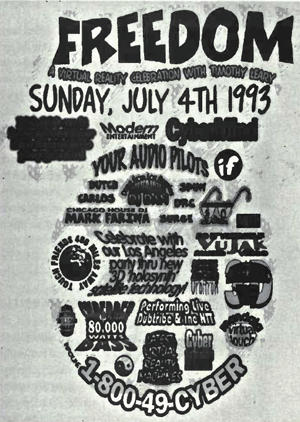
Countercultures are sometimes tolerated by the governors. They can, with sweet cynicism and patient humor, interface their singularity with institutions. They often work within the “governing systems” on a temporary basis.
As often as not, they are unauthorized.
THE LEGEND OF THE RONIN
The ronin ...has broken with the tradition of career feudalism. Guided by a personally defined code of adaptability, autonomy, and excellence, ronin are employing career strategies grounded in a premise of rapid change.
-- Beverly Potter, The Way of the Ronin
Ronin is used as a metaphor based on a Japanese word for lordless samurai. As early as the 8th Century, ronin was translated literally as “wave people” and used in Japan to describe those who had left their allotted, caste-predetermined stations in life: samurai who left the service of their feudal lords to become masterless.
Ronin played a key role in Japan's abrupt transition from a feudal society to industrialism. Under feudal rule, warriors were not allowed to think freely, or act according to their will. On the other hand, having been forced by circumstances to develop independence, [ronin] took more readily to new ideas and technology and became increasingly influential in the independent schools.
-- Potter, op. cit.
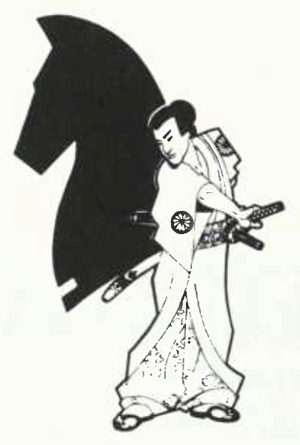
The West has many historical parallels to the ronin archetype. The term “free lance” has its origin in the period after the Crusades, when a large number of knights were separated from their lords. Many lived by the code of chivalry and became “lances for hire.”
The American frontier was fertile ground for the ronin archetype. “Maverick,” derived from the Texan word for unbranded steer, was used to describe a free and self-directed individual.
Although many of the ronin's roots ...are in the male culture, most career women are well acquainted with the way of the ronin. Career women left their traditional stations and battled their way into the recesses of the male-dominated workplaces... Like the ronin who had no clan, professional women often feel excluded from the corporate cliques' inside tracks, without ally or mentor.
-- Potter, op. cit.


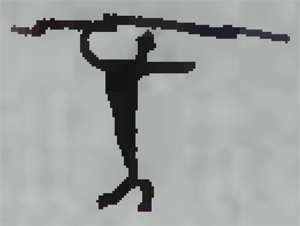

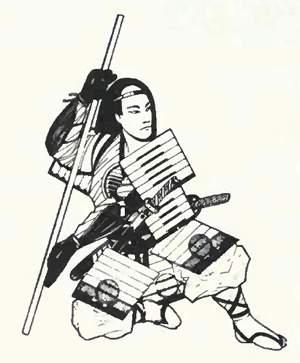


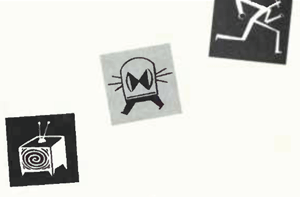





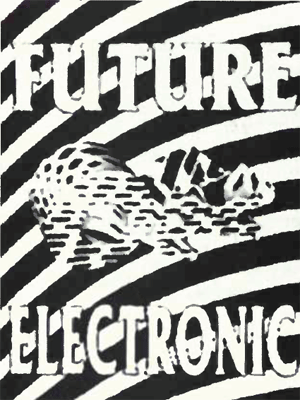


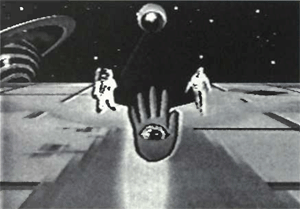

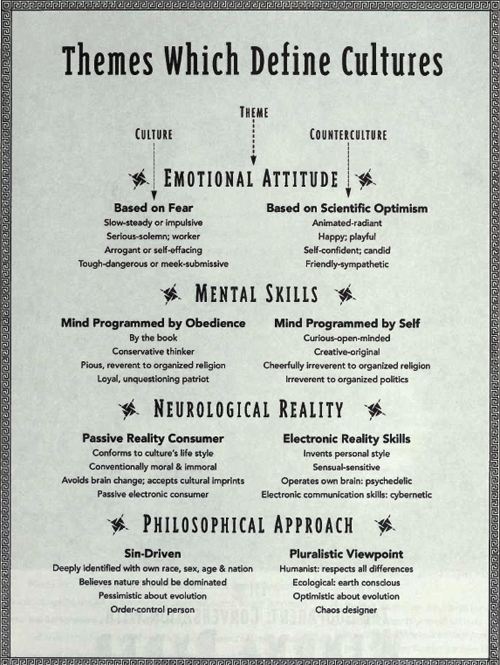


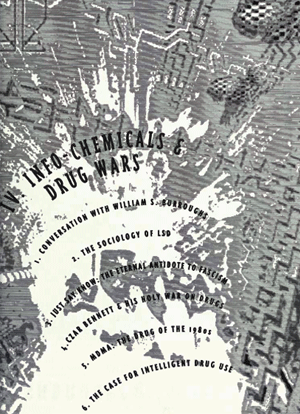
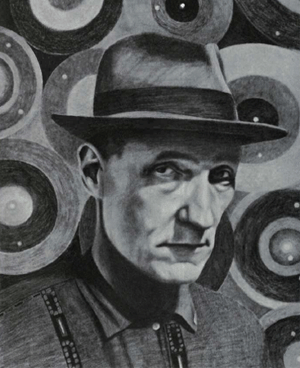

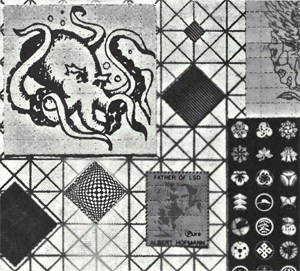


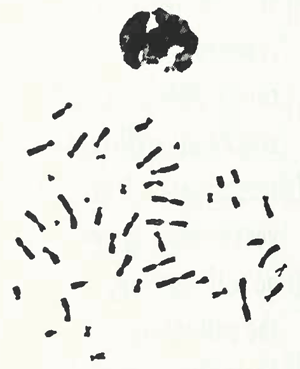
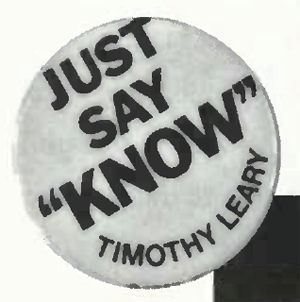

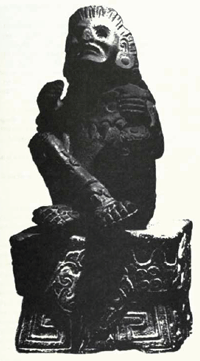

 Czar: (1) a king or emperor. (2) a tyrant, autocrat.
Czar: (1) a king or emperor. (2) a tyrant, autocrat. 

